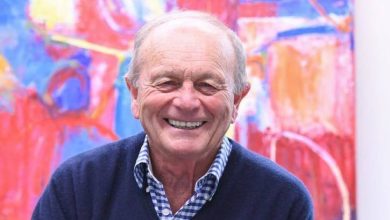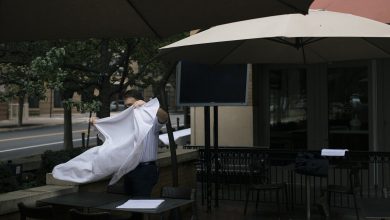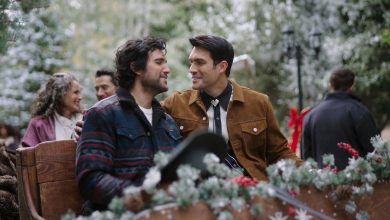Gigs on wheels help drive the return of Melbourne’s music scene, but venues brace for a slow summer

abc– In 1976, rock legends AC/DC took to Swanston Street to film a blistering rendition of It’s a Long Way to the Top, from the back of a flatbed truck.
Almost 45 years later, local artists are gearing up to follow in their footsteps as part of Rock Around the Block, a series of roving music gigs performed on the streets of inner Melbourne.
Funded by the City of Yarra, the pop-up performances will take centre stage outside of restaurants and various venues for just 30 minutes at a time, before rolling off to bring live music to another spot.
“It was my wife who actually came up with the idea,” booking agent Sean Simmons said.
“She said: ‘How about the old AC/DC thing of getting bands on trucks again? It’s COVID-safe, ticks all these boxes, and bands can continue to play.’ So, here we are.”
The line-up includes artists such as The Killjoys, Hollie Joyce and Kee’ahn, with a different set of musicians taking to the truck’s stage over three weekends in December.
Notably, the half-hour slots allow artists to perform at least four times per evening.
“It doesn’t give the public enough time to congregate and create large gatherings, because that’s not what we’re trying to do,” Mr Simmons said.
“We’re trying to play to the people who are already dining outdoors, across various venues or restaurants.”
After the disruption caused by the pandemic, finding new ways to give local musicians a platform — while still abiding by restrictions — has been at the forefront of Mr Simmons’s summer plans.
Still, he believes it’s also propelled him down more creative routes, like Rock Around the Block.
“I think everyone in the music industry, whatever their role might be, has been forced to innovate, to think of unique ideas to keep their businesses going, and try to adapt to the changing landscape,” Mr Simmons said.
A welcome return to live music
For singer-songwriter Kee’ahn, her part-time job as a recruitment officer for Indigenous Australians has been a “saving grace” through the pandemic.
The 23-year-old Kuku Yalanji, Jirrbal and Zenadh Kes musician released her debut single back in May, but due to the lockdown, hasn’t been able to go through the usual channels to promote it.
“This is my COVID-normal single release,” Kee’ahn said.
“Hopefully when things calm down I can tour with it … I miss being on stage in front of people.
“You get a high that’s definitely lessened when you’re only doing online Instagram performances or something like that.”
For Mr Simmons, it’s been a concern that musicians, particularly up-and-coming ones like Kee’ahn, haven’t been able to tour and play to live crowds.
“The only music world that she’s known has been this one,” Mr Simmons said.
“It’s one thing to say there’s been a loss of income, but it’s also the loss of a sense of self-worth. It’s what they do.”
Calls for more clarity on restrictions
Next week, Melbourne Music Week officially kicks off — the first live-music festival to return to the city since the start of the pandemic.
Usually running for 10 days, this year’s Melbourne Music Week has been reinvented into a three-month-long extended program featuring, for the very first time, an all-Australian line-up.
It’s a promising sign that the music scene’s recovery may not be too far away, but many indoor music venues are still anxiously waiting on news for the months ahead.
On Sunday, the Victorian Government is expected to reveal further steps out of restrictions.
Sally Mather, manager of the Forum Theatre and a member of the COVID advisory panel for Music Victoria, says live venues need to know precise dates or trigger points for subsequent phases in order to properly prepare for future gigs.
“For us at the Forum, we would normally plan three to six months ahead at a minimum, which we can’t do without knowing a bit more about what the next stages are.”
The Forum can fit more than 600 people, but under current restrictions is operating at just 25 per cent of its seated capacity.
Just how many punters venues will be allowed to have after the next round of announcements is still unknown, but Ms Mather says most venues need to fill roughly 70 to 80 per cent of their total capacity to be financially viable.
“Budgets are incredibly tight. There are costs that don’t go down no matter how many people you have in the room,” Ms Mather said.
“I think it’s really important that we try and get to as close to normal as possible within six months for our industry to be successful, and for us to not lose a lot of our key venues.”
For Sean Simmons, while the next few months are crucial, they also present an opportunity for local acts to enjoy more time in the spotlight.
“I can’t see international acts coming to Australia for a long time,” Mr Simmons said.
“It’s a real chance for emerging acts to pierce through and be heard.”
It’s a chance Kee’ahn is keen to take up.
“We have all this creative energy, but we don’t know where to put it.”
“It’s all just going to burst out when everything is able to get back to COVID-normal.”




